Explainer
- Explainer
- Science
Trees have biological clocks too. Here’s how their leaves change colour
A red-golden carpet is unfurling across the more temperate corners of our continent. Here’s how trees – and ‘leaf peepers’ – know it’s autumn.
By Jackson Graham and Angus Holland
Take the scenic route north-west out of Hobart into Tasmania’s Mount Field national park and, as you climb into the chilly alpine highland region, you won’t be able to miss it: one of Australia’s most unusual and spectacular natural displays.
It’s around Anzac Day that the spartan hillsides suddenly bloom in a kaleidoscope of yellow and orange, thanks to a unique shrub known as the fagus (pronounced “fay-gus”). Indeed, the “turning of the fagus” is quite an event in these parts. “It’s an ecological phenomenon,” says forest scientist Yoav Daniel Bar-Ness, a fagus fan who first witnessed it 20 years ago and now visits regularly.
Nothofagus gunnii, also known as deciduous beech or tanglefoot (due to its habit of tripping up unwary hikers), is at least 30 million years old, a relic from the time when Australia was still part of the single giant continent Gondwana. This species grows only in Tasmania and is one of just a handful of native Australian plants that lose their leaves, preceded by its brief blaze of glory. “The tanglefoot is such a weird oddity,” says Bar-Ness, founder of the Tasmanian tour company Giant Tree Expeditions. “It reminds you of just how different Australia is botanically. We’re not about four seasons, we’re about water and drought and heat and fire.”
But why do the fagus and other plants colour their leaves in autumn? Why do some trees lose their leaves, but others don’t? And what are “leaf peepers”?
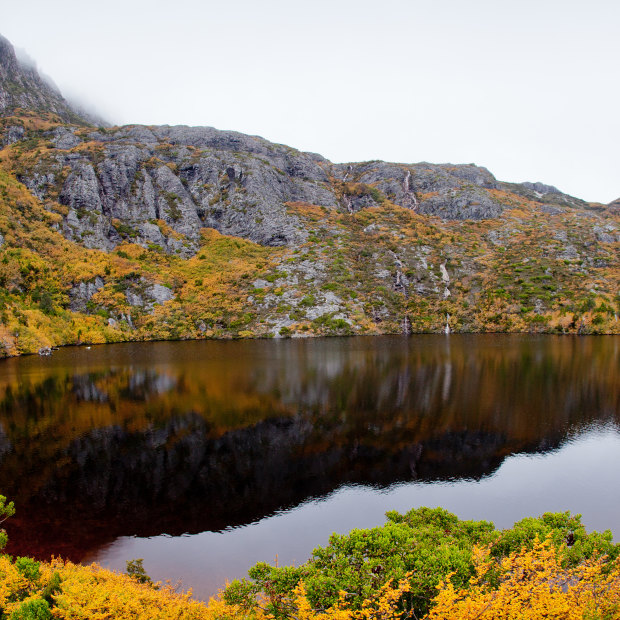
The ancient native plant Nothofagus gunnii in autumn at Cradle Mountain-Lake St Clair National Park, Tasmania. Credit: Getty Images
How do trees know what season it is?
As autumn approaches, some trees receive cues from their environment that it is time to start battening down the hatches and prepare for winter. Shorter days – fewer hours of daylight – are the major trigger, but temperature and rainfall also play a role. “They have a biological clock that allows them to measure day length,” says Greg Moore, senior research associate at the University of Melbourne’s Burnley College. “The length of the day is a very accurate measure of season.”
These trees, known as deciduous from the Latin “falling off”, have evolved over millions of years to survive in cold climates. The winter-deciduous trees (those that drop their leaves for winter) that line Australia’s streets and populate our parks – oak, maple, plane and birch among them – are imports from the northern hemisphere. With a handful of exceptions, such as white and red cedars and boabs, Australian natives are evergreen, as are our imported conifers. “The was kind of lucky in the sense that it was the deciduous species that had enough things going for it that it was able to survive to now,” says Greg Jordan of the University of Tasmania.
In the European autumn, large leaves become a liability: as the season wanes, they no longer work as effectively to turn sunlight into energy and are threatened by frosts that can freeze the fluids within and kill them in an instant. “Everything’s trying to conserve resources to have them available for the best growing season, either avoiding cold winters or hot, dry summers,” says Dr Dave Kendal of the ecology consultancy Future in Nature. “There’s always these tradeoffs in nature.”
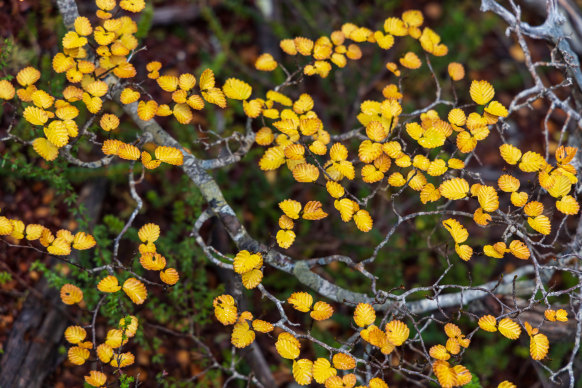
Nothofagus gunnii leaves in autumn. Credit: Getty Images
Storms are another threat, according to the German forester and author Peter Wohlleben, and losing leaves makes a tree more aerodynamic and better equipped to survive the strong winds that typically batter northern Europe in winter. Fewer leaves mean a reduced surface area equivalent to a sailing boat dropping its mainsail, he writes in his book The Hidden Life of Trees. “The trunk and branches are shaped so that their combined wind resistance is somewhat less than that of a modern car.”
‘You don’t need a strong wind, you don’t need to touch them, they literally fall off under their own weight.’
In autumn, winter-deciduous trees begin a tightly controlled process to harvest their leaves’ nutrients, storing them in other parts of the plant for the following year and then getting rid of the depleted leaves safely. It’s as if a switch gets flicked, says Moore. “Instead of producing growth hormone, it produces an inhibitor that makes it very easy for the plant to shed its leaves without causing significant damage. The leaves literally just drop off. You don’t need a strong wind, you don’t need to touch them, they literally fall off under their own weight.”
Some of the most picturesque deciduous trees line streets of regional towns (not least many of the 500 or so stately avenues of honour across Australia memorialising the fallen of conflicts past). Autumn colours are still one reason the trees are popular, but gardeners also like their practicality. “They were planted once to remind people of home,” says Peter Jobson, a botanist at the Botanic Gardens of Sydney. “They can be really great in winter; they allow light to get to the ground and in summer, they are great and shady.”
Why do some leaves change colour?
The big picture is that most life on Earth depends on a process carried out by plants, algae and some bacteria, which you might remember from high-school biology: photosynthesis. In trees, leaves are the factories that convert light energy, carbon dioxide, and water into sugars that the plant lives off. During part of the process called transpiration, leaves “breathe out” water vapour and oxygen.
‘They are always present there but masked by the dominance of the chlorophyll and green pigment.’
To understand leaf colour, we need to zoom in on one part of this cycle: plants capturing sunlight. Leaf colour comes from the pigments of chemical compounds that enable plants to turn sunlight into energy. The most visually dominant of these pigments is chlorophyll, which produces hues of green on leaves (anywhere between a few hundred to hundreds of thousands per tree).
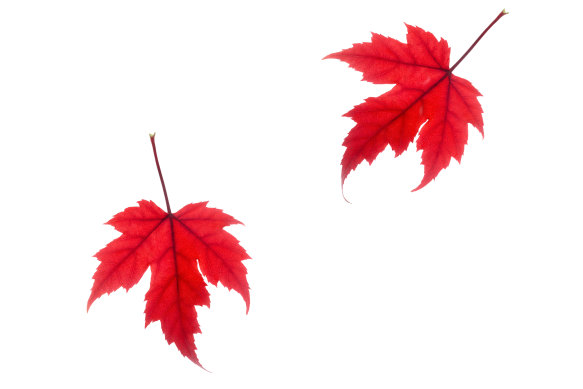
Credit: Getty Images
But chlorophyll isn’t the only compound in leaves; it’s just the dominant one during the growing season. “What we cannot see with our eyes under normal conditions are these yellow and orange colours which are produced by different types of pigments called carotenoids,” says Sergey Shabala, chair of plant physiology at the University of Western Australia. “They are always present there but masked by the dominance of the chlorophyll and green pigment.” Carotenoids are better known for giving carrots and pumpkins their colour.
As sunlight fades, the tree pauses making chlorophyll to conserve water and nutrients in autumn. “When chlorophyll starts to be produced in smaller quantities or be destroyed by seasonal factors, the green colour disappears, and suddenly you start to see this orange and yellow coming to the surface,” Shabala says.
Some biologists have theorised that the colour change, at least in some species, is not just a passive process but an active one with several goals, particularly in trees whose leaves turn red, a colour produced by another kind of pigment called anthocyanins. A tree’s “intention”, it is theorised, might be to signal to birds that their fruit is ripe, to protect its late-stage leaves from light damage while the process completes, to undermine insects’ camouflage, or to warn destructive pests such as aphids that the tree is well-defended with toxins. Or all of the above.
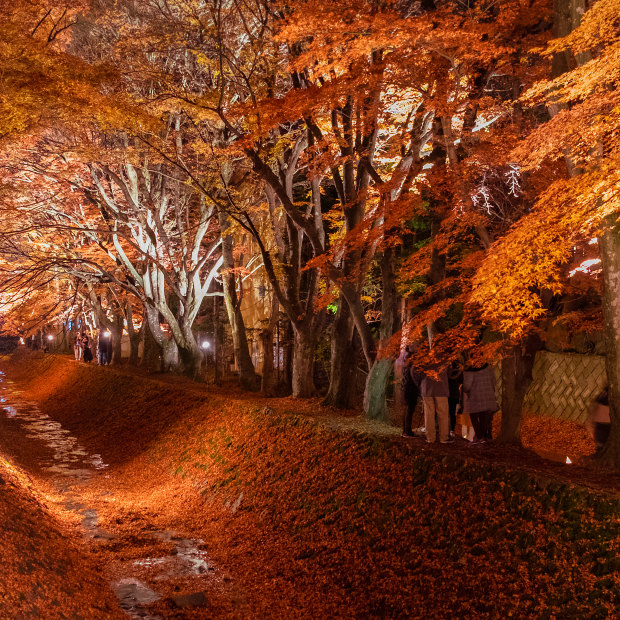
The “Momiji” tunnel of maples near Lake Kawaguchi, Japan.Credit: Getty Images
More research is needed, however, to be sure. “Many questions remain,” observed David Lee and Kevin Gould in a journal article for Harvard University. “If anthocyanins fulfil an important physiological or ecological function for certain plants, why then do some plants not produce such pigmentation? And why aren’t more leaves red all the time?”
We do know that some autumns produce bolder colours than others due to the conditions in the previous spring and summer. Good rainfall and mild conditions are best, followed by a sharp drop in temperatures. “Because of that, you’ll see really bold colours; perhaps the oranges come out really quickly, or go to a red and a purple and then the leaves drop off,” says Marion Whitehead of the Blue Mountains Botanic Garden Mount Tomah, which is Australia’s highest-altitude cool-climate botanic garden. “If you’ve had quite a wet and milder autumn – nights that aren’t too cold – what you tend to end up with is a really slow season. They might just go brown and fall off. You don’t get that sharp display of clear colours.”
Sometimes, it’s not autumn that causes a tree’s leaves to turn but stresses such as drought or a withdrawal of nutrients. The quickest way of limiting moisture loss from the plant is to get rid of the leaves that expel water – the transpiration process.
What are “leaf peepers”?
Charlotte Harris and her partner, Edmund, considered going to Japan for the renowned spring cherry blossoms several years ago. Then, they came across the hues of the momiji, a Japanese maple that gives a fiery intensity to tranquil parklands, and booked a trip for autumn instead. “We were very excited about finding these golden forests and bright red canopies,” Harris says. “You could go to the park and enjoy it with no one else there.”
When we cross paths in Melbourne’s Royal Botanic Gardens, Harris is rustling through leaves with her son, one-year-old Alex, and daughter, Sophie, who’s just turned five and has been badgering her mum to see the colourful displays she understands as her birthday colours.
Outside the city, it’s often the colder mountainous areas of Australia’s south-east where tourists trek to glimpse autumn leaves. “Leaf peepers are a real thing,” says Marion Whitehead of hobbyists who travel to witness – and, of course, Insta-photograph – the changing of the colours. Daytrippers wielding bags of camera gear and smartphones start to arrive around Anzac Day every year, and continue until the limbs of many of the Blue Mountains gardens’ trees are bare. “Often, we are turning people away at the gate because of the parking by about 10am.”
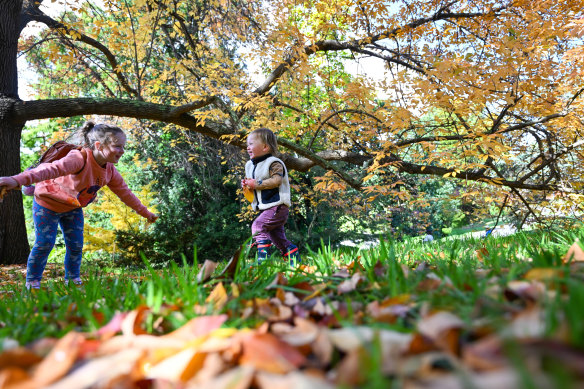
Sophie and Alex play in the leaves at the Royal Botanic Gardens in Melbourne. Credit: Joe Armao
The actual “peeping” term appears to have emerged in the United States in the 1960s and is sometimes used derogatorily to describe leaf tourists who clog up roads in picturesque regions. Some towns in the leafy state of Vermont sometimes even block roads to keep visitors away, with the picturesque Sleepy Hollow Farm near Woodstock a notorious hotspot.
Residents have even raised funds to pay for security patrols, arguing that “Instagram- and TikTok-fuelled tourist ‘influencers’” had changed the neighbourhood to the point that it was untenable. “Crowds,” they claimed, “commonly surge to hundreds of people at one time, and poorly behaved tourists have damaged roads, had accidents, required towing out of ditches, trampled gardens … and verbally assaulted residents.”
In Finland, trekking to see autumn leaves is called ruskaretki (after the word for autumn, “ruska”). The Japanese, meanwhile, call it momijigari, a portmanteau of momiji, meaning “red leaves” or “maple”, and kari “hunting”, or kanpūkai, “getting together to view the leaves”, a seasonal pastime (nearly) as important as watching the cherry blossoms in spring.
‘In Australia, of course, the eucalypts are holding their leaves year-round, beautiful trees in themselves.’
London’s Kew Gardens has 11,000 trees, about three-quarters of which are deciduous. The result is several weeks of autumnal palettes transitioning at different rates. “We’re in western London; it’s about 51 degrees latitude, so the equivalent in the southern hemisphere would be a fair way south of New Zealand,” says Richard Barley, an Australian who is Kew’s gardens director. “The sun gets very low in winter, and winter day length is comparatively short. And that’s the point; there’s not enough light for photosynthesizing.”
The result is a lower, weaker light than we often find in Australia, he says. “There’s a great beauty in the seasonality of a place like England or other parts of Europe. In Australia, of course, the eucalypts are holding their leaves year-round, beautiful trees in themselves. Outside my window, there’s the most magnificent Victorian eucalypt, Dalrymple Leanna, which gives me great pleasure to look at every day. But it’s a different-looking landscape entirely.”
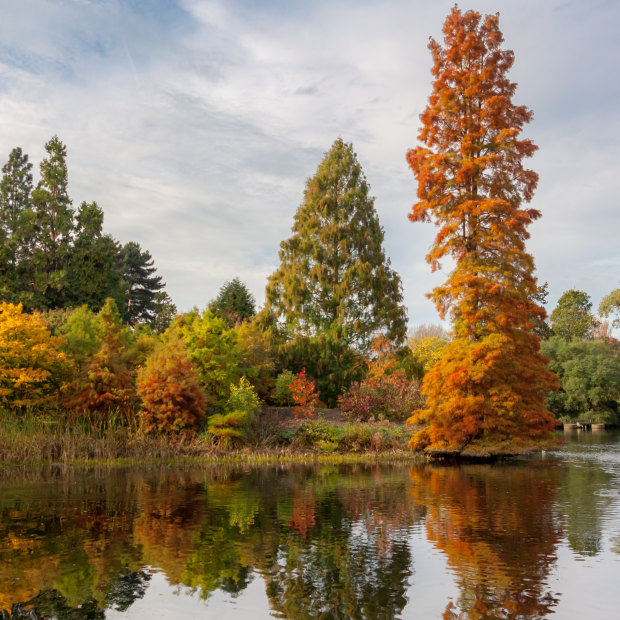
Autumn in Kew Gardens in London.Credit: Getty Images
Sugar maples from North America’s east coast are the most reliably bright red, but Barley’s favourites are another North American called Tupelos, which produce a rich golden hue. “You often find it growing near water, so you get that reflection with these beautiful layers of bright golden yellow.”
In Australia, says Marion Whitehead, the Blue Mountains garden draws Chinese tourists to see the fire-engine-red maples. In China, red is an auspicious colour associated with life-generating energy and prosperity. “And then you have the TikTokers who come up for the autumn foliage.”
While the crowds retreat in winter, for Whitehead, a self-confessed “tree nerd”, the spectacle isn’t over once the leaves fall. “It’s often seeing the structure of the tree that is the reward,” she says. “There are really beautiful patterns in their zigzag architecture.”
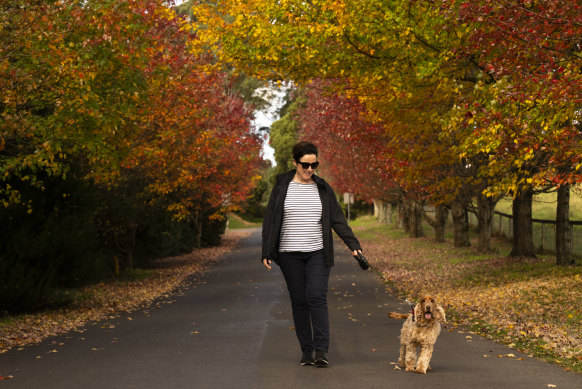
Karon walks her dog, George, in Burrawang, NSW.Credit: Janie Barrett
What should we do with all the leaves that fall off?
Put down that leaf blower for a start. Fallen leaves are increasingly recognised as a useful resource for the garden, not only as mulch but as a habitat for all sorts of insects and tiny animals. “A forest has the richest soil there is, and that happens because leaves are falling off the trees and decomposing right there, and organic materials are going back into the soil,” landscape professor Susan Barton told The New York Times last year. “We should be doing that in all of our landscapes, but we’re not.” Leave the leaves alone, another expert suggested; failing that, rake them onto garden beds or turn them into mulch. “Virtually all species will compost well,” says Moore.
‘Removing all the leaves and not having any of that present over a number of years gradually depletes the soil.’
In London, Kew Gardens collects leaves from beneath trees where the quality of the turf is carefully managed. “But, in the end, they all come back once that has gone through the process of composting,” Barley says. The composting process breaks down the organic material and kills off weed seeds and potential pathogens. In other areas, though, workers run mowers over fallen leaves to let them decompose in situ. Both methods help to nourish the soil and house useful bugs, worms and fungi. “Removing all the leaves and not having any of that present over a number of years gradually depletes the soil.”
Scientists have gone so far as to show that some trees can even “communicate” through root systems and soil fungi. This research, Barley says, is still emerging. “They’re not people,” he warns of a tendency to anthropomorphise plants. “But there are clearly some sort of biological processes that can take place that can allow a sort of message and feedback to occur.”
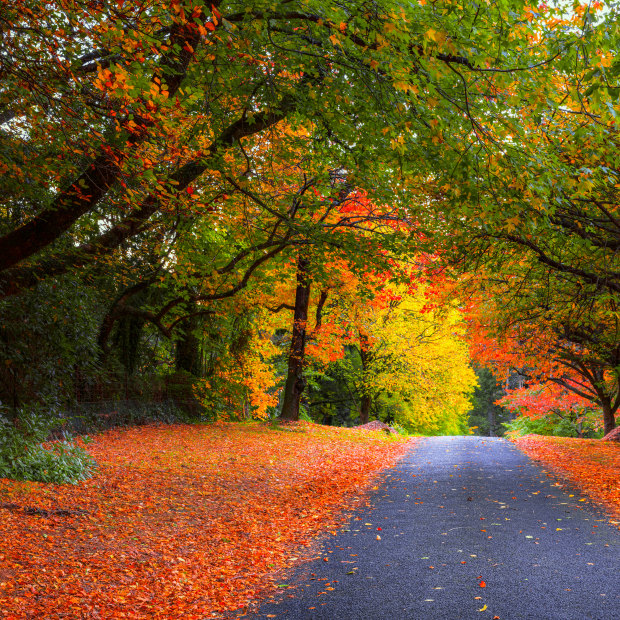
A carpet of autumn leaves lines the road of the township of Mt Wilson in the Blue Mountains.Credit: Getty Images
In the Blue Mountains, autumn is Whitehead’s favourite season. “It’s not too cold; you get this beautiful breeze; there’s still light when you get there and light when you go home,” she says. It’s a busy time for the gardeners – raking up leaves, bagging them and keeping them as mulch for the coming seasons. One group of trees drop leaves at a glacial pace. “It never ends for three months. I ordered in a leaf sucker and mulcher, it was meant to vacuum them up and then mulch them, and it just didn’t work very well; you have to do it by hand.”
‘I see autumn as a battening down of the hatches and getting ready for winter, but it’s definitely not decay to me.’
Autumn is also a time for preparing for the seasons ahead. “We just planted 8000 daffodil bulbs in our meadow, ready for spring,” Whitehead says. “I see autumn as a battening down of the hatches and getting ready for winter, but it’s definitely not decay to me. To me, it’s almost like the little bit before rebirth because it is when you’re planting all your bulbs.”
The fagus, meanwhile, has one more trick up its sleeve, says Bar-Ness. When spring comes back around, it grows new leaves, crinkled up like “origami” inside their buds. “One of the theories is that when the growing season is very short, they need to open up their buds quickly and start photosynthesizing to take advantage of that short period of time,” he says. When the plant judges it to be the right moment, it springs into action in a different burst of colour. “It’s this beautiful bright lime green.”
Get fascinating insights and explanations on the world’s most perplexing topics. Sign up for our weekly Explainer newsletter.
Let us explain
If you'd like some expert background on an issue or a news event, drop us a line at explainers@smh.com.au or explainers@theage.com.au. Read more explainers here.